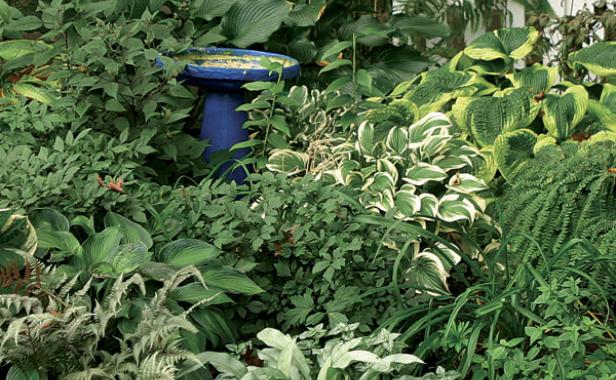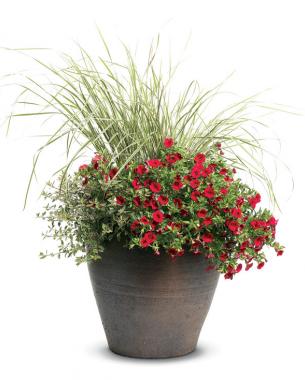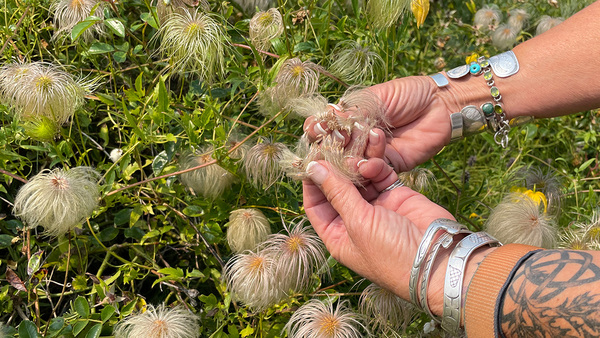I’m already out of breath, and it is only 6:20 a.m. My list for the day includes getting Evan, my 12-year-old son, out the door to catch the school bus; tackling at least one load of laundry; responding to a suspicious email from Evan’s math teacher; planning something other than fast food for dinner; and getting to work on time. Then there’s that silent competition with my neighbor for the best-looking garden in the neighborhood, even though mine looks like a weed bomb went off in it (I wonder if she threw it?).
With so many time demands in our lives, our gardens should be the least of our concerns. Why can’t someone invent self-cleaning gardens like our self-cleaning ovens? You simply flip a switch and the garden takes care of itself. It does its own deadheading, weeding, staking, edging, watering, and mulching, and the deluxe model will actually cut fresh flowers and arrange them in a vase for you. I know—“Keep dreaming.” But there is no reason why we cannot have gardens that are low maintenance and fit into our on-the-go lifestyles. Here are some trusty maintenance strategies that I use to put precious time back in my pocket.
1. Plant in masses

More is better, right? Yes, if you are referring to chocolate or time-saving design strategies for gardens and hard-to-plant areas in your landscape. When designing or reworking garden beds, make it easy on yourself by planting fewer varieties but in greater numbers. By doing so, you reduce the number of different maintenance tasks and tools required by applying the same repetitive motion longer to a greater number of plants (this also allows for safer daydreaming).
Many of us curse bugleweed (Ajuga spp. and cvs., USDA Hardiness Zones 3–9), sweet woodruff (Galium odoratum, Zones 5–8), creeping phlox (Phlox subulata cvs., Zones 3–8), and other ground covers, labeling them thugs. In all fairness, however, they are only doing what comes naturally to them: covering ground. Take advantage of those tough, free-spirited roots, and plant them in hellstrips under shallow-rooted trees or on slopes where mowing is a challenge.
2. Employ your power drill as a power planter

Bulbs are a joy to behold in the garden, but planting them can generate an entirely different emotion. Thank goodness for the power drill and bulb auger (a device used for boring holes). Bulb augers generally come in two sizes: one for smaller bulbs and a larger version for tulips (Tulipa spp. and cvs., Zones 4–8), daffodils (Narcissus spp. and cvs., Zones 3–9), and other big boys. Augers fit into most electric or battery-operated drills. You can purchase them at garden centers or online. Planting bulbs has actually become one of our fall family activities. My son loves to drill the holes (what child doesn’t love power tools?), and I walk behind tossing in bulbs. You can also apply this time-saving technique for planting annuals, turning and aerating your compost pile, or mixing potting-soil recipes.
3. Group plants with similar moisture needs

4. Avoid putting thirsty plants in hard-to-reach places

Another watering time-saver is to use drought-tolerant plants where water is scarce or hard to get to, such as the back of deep beds or around roadside mailboxes. Instead of lugging water to the “back 40,” I keep it simple. One section of my garden is located where the automatic sprinkler system—another great time-saving tool—doesn’t reach. Realizing that plants in this area will rely solely on what comes from the sky, I planted drought-tough plants like purple coneflowers (Echinacea spp. and cvs., Zones 3–9), daylilies (Hemerocallis spp. and cvs., Zones 3–10), and false indigos (Baptisia spp. and cvs., Zones 3–9). I gave them a big drink of water after digging them in, and then I turned my back (I’m known for tough love in the garden). Years later, they continue to rally to the challenge and look great.
5. Don’t buy rampant reseeders
 Photo/Illustration: Steve Aitken
Photo/Illustration: Steve Aitken
When selecting plants, be cautious of rapid self-sowers. If a plant is known as a “fertile myrtle,” leave it on the garden-center shelf. Plant tags, unfortunately, don’t usually state if a plant is overly generous with its seeds; we usually find this out through trial and error or from exasperated fellow gardeners. So do your homework. Some reseeders to beware of include mallows (Malva spp. and cvs., Zones 3–8), bachelor’s buttons (Centaurea montana and cvs., Zones 3–9, photo, right), black-eyed Susans (Rudbeckia spp. and cvs., Zones 3–11), and most biennials. If you simply must have the plant, stay on top of deadheading; otherwise, the free-spirited progeny will germinate wherever the breeze may carry them.
6. Use preemergent herbicides

Applying a pre-emergent herbicide to the soil in early fall or spring will also cut down on weeding. These herbicides do no harm to existing plants; their mission is to search and destroy seeds, and in many cases, their aim is nonselective. So be careful where you apply pre-emergents such as corn gluten (organic, photo, right) or Preen (synthetic). You may end up throwing the baby out with the bathwater if you apply these to areas where you grow biennials and short-lived perennials such as delphiniums (Delphinium spp. and cvs., Zones 3–7) or rose campions (Lychnis coronaria and cvs., Zones 3–8), which rely on reseeding for future flowers.
7. Pluck weeds when the soil is moist

8. Avoid troublemakers

Who has time to play nursemaid or bodyguard to plants? I work with varieties that are disease resistant or less likely to be on a critter’s buffet menu. Some plants can’t help themselves—they are prime targets for bugs or fungal diseases. Plant heliopsis (Heliopsis helianthoides cvs., Zones 4–9) and here come the red aphids. Just try sneaking in some garden phlox (Phlox paniculata cvs., Zones 4–8, photo, right) or hostas (Hosta spp. and cvs., Zones 3–9) without powdery mildew or deer finding out. To reduce headaches, I avoid the troublemakers and stick with plants that are insect, disease, and browse resistant in areas where these problems arise.
9. Go with plants that require little pruning

Let’s face it. Pruning and deadheading are necessary evils but ones we have control over. To reduce time spent on these laborious tasks, I choose shrubs that require little or no pruning and herbaceous plants that bloom without my assistance. Avoid woody plants that sucker or are persnickety, such as lilacs (Syringa spp. and cvs., Zones 3–8) and hybrid roses (Rosa cvs., Zones 4–11).
Likewise, select herbaceous plants that have a long bloom without deadheading. Some terrific perennials to consider are butterfly weeds (Asclepias spp. and cvs., Zones 3–11), sneezeweeds (Helenium spp. and cvs., Zones 4–8), and bugbanes (Actaea spp. and cvs., Zones 4–9). The annual contingent includes calibrachoas (Calibrochoa cvs.), impatiens (Impatiens spp. and cvs.), and vincas (Catharanthus roseus cvs.).
10. Forgo finesse during fall cleanup

By mid-autumn, the joy of gardening has usually worn thin and I’m ready to mow down the whole kit and caboodle. Depending on my mood, I will use a lawn mower, weed wacker, miniature chain saw, or hedge trimmer to whack almost everything in my perennial garden to within a few inches of the ground. Don’t worry. The plants can take it, and it’s a great release after a rough day with the kids, at the office, or in traffic.
Anytime after October 1 is the best time to have at it in my Zone 4 yard. Be sure to rake sheared foliage from your beds to reduce future fungal and insect problems. Skip over woody-based plants, like lavenders (Lavandula spp. and cvs., Zones 5–9). They resent being pruned in the fall. You may also want to bypass plants like purple coneflowers and ornamental grasses for winter interest or to feed the birds.

















Comments
Log in or create an account to post a comment.
Sign up Log in